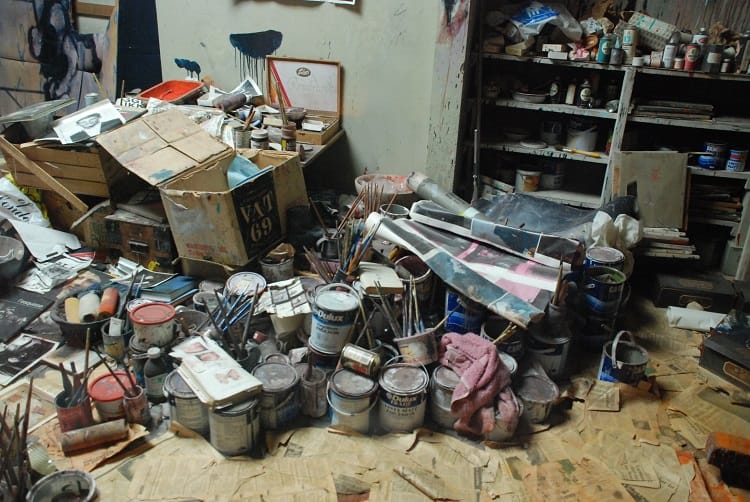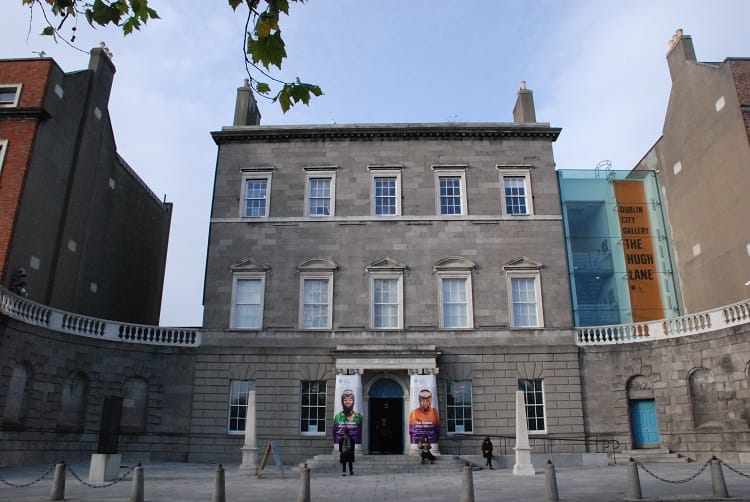What’s the best way to tell area residents about plans for a new asylum shelter nearby?
The government should tell communities directly about plans for new asylum shelters, some activists and politicians say.
With extra funding, those who run the Hugh Lane Gallery hope to bring in blockbuster works and grow its visitor numbers.

The Hugh Lane Gallery has a national remit, so, in a sense, it can’t be seen as just belonging to Dublin, said Barbara Dawson.
While it is owned by Dublin City Council, it is also the foremost gallery in the country after the National Gallery of Ireland, said Dawson, the gallery’s director, at Monday’s meeting of the council’s arts committee.
“That’s very unusual in a local authority,” she said.
But the Hugh Lane gets less funding than the National Gallery and it isn’t as centrally located – tucked as it is on Parnell Square near the more-neglected end of O’Connell Street.
Dawson, however, has a plan.
Over the next five years, the gallery aims to double visitor numbers, increase its funding, and purchase a major artwork or series of artworks.
It’s an ambitious vision which raises questions about the gallery’s future, and how it should position itself in the coming years.

Laia Zacarias walks slowly past the white gallery walls. She pauses at George Russell’s Stone Carriers, observes the painting’s blue figures, bent double, and moves on.
In a nearby room, a bespectacled security guard keeps watch over the artworks, to a soundtrack of clacking heels on wooden floors.
Zacarias, a Barcelona-born artist, says that it’s here she comes to view “the great art”: the impressionist works by Édouard Manet, Claude Monet and Pierre-Auguste Renoir.
They keep her coming back time and again. “Here I can stay for hours,” she says.
She glances around. It’s Saturday afternoon, but few visitors have joined her in this room of Irish portraiture. That’s a state of affairs she finds odd.
For Zacarias, the Hugh Lane Gallery trumps the National Gallery of Ireland hands down. “This gallery has it all,” she says.
It’s the impressionist pieces, not the second-floor contemporary exhibits, that the Hugh Lane should focus on promoting, she thinks.
Of course, the more funding a museum or gallery has, the more it is likely to achieve, says Zacarias. But that still won’t get her across the river to Merrion Square. “The National Gallery doesn’t have spirit. Everything is mixed there,” she says. “It isn’t making any point.”
The Hugh Lane should abandon that path, the dual-curation of the older works – those presented by Hugh Lane in 1908 when the gallery first opened – and the modern exhibits, Zacarias says.
“I don’t think they match,” she says.
Change is needed, said gallery director Dawson at Monday’s meeting.
At the moment, the gallery’s “Strategic Vision 2018-2023” – an ambitious draft plan to increase funding and visitor numbers and enhance the gallery’s collection over the next five years – points to several needs.
It points to the need to “radically increase audience participation and community engagement”, the need for a different approach in the gallery’s core programming, and the need to refurbish the gallery space.
A refurbishment of the gallery is floated for early next year, with funding of €3.5 million already set aside by the council.
In addition, the gallery aims to hold three “internationally renowned” exhibitions annually and acquire a major work or collection of works on par with Francis Bacon’s studio, which it already hosts.
These, said Dawson, would be “blockbuster” exhibitions. They would attract world media, and “will ignite, for Dubliners, excitement in the gallery”, she said.
At the moment, Hugh Lane Gallery officials are looking, for inspiration, towards the similar-sized Musée d’Art Moderne de la Ville de Paris, the city gallery that serves France’s capital.
But Dublin’s gallery needs more staff before pressing ahead, including a head of development to increase gallery funding, an education curator, a clerk and a facilities manager to maintain and improve the gallery space, she said. “All of this requires finance, as we know.”
Over the past five years, the Hugh Lane has received €11.6 million in funding, in addition to the €3.5 million for the renovation. But it needs an extra €2.4 million over the next five to see this vision through, said Dawson.
The gallery is hoping that the council will increase its funding incrementally, by €100,000 in 2018, up to €350,000 extra by 2022.
This means that over five years, the council will have provided €1.2 million in extra funding to the gallery. (Dublin City Council’s budget for 2018 is €917 million.)
Additional fundraising through acquisitions, exhibitions and community engagement, will raise an additional €1.2 million, according to Dawson.
While the plan is challenging, said Dawson at Monday’s meeting, “we feel that with innovative programming and support it can be achieved”.

Through the Doors
In recent years, the Hugh Lane Gallery’s visitor numbers have grown.
It attracted more than 180,000 visitors in 2016, compared to 156,373 in 2015 – a 15 percent increase. In October 2017, 17,537 visitors came to the gallery, compared to 15,283 in October 2016, according to Dawson.
By comparison, the National Gallery of Ireland saw 718,000 visitors pass through its doors in 2015, according to Fáilte Ireland.
Two visitors to the Hugh Lane Gallery on a recent Saturday afternoon were Susan and Denis Coleman, sat gazing at Gustave Courbet’s In the Forest.
Busier by now, a nearby group gathers around Renoir’s Les Parapluies, while the bald, bespectacled security guard takes a chair.
The Colemans live in Kentucky in the United States, about thirty miles from Louisville.
Their guidebook recommended a trip to Parnell Square. “We like it,” says Denis, burly in a black mariner cap. “Once we found it.”
Their nearest gallery or museum back home, comparable to the Hugh Lane Gallery, is Louisville’s Speed Museum, an art gallery known for its European and modern artworks. “Our museum is smaller, though,” says Denis. “I mean we have the masters, but this is much better.”
Originally from Oxford in the United Kingdom, Susan is used to visiting the behemoths that London has to offer in the way of art galleries.
But Francis Bacon’s studio at the Hugh Lane “is amazing”, she says. It should be highlighted more, she says.
At Monday’s meeting, some councillors were confident that increased funding from the council would see Dawson’s strategic plan reach fruition by 2023.
Labour Councillor Rebecca Moynihan was curious as to the level of funding the Hugh Lane Gallery receives compared with the National Gallery of Ireland, a state-owned institution.
“Because it seems to me that if we are trying to run a world-class, municipal gallery, we need to be matching our commitment in funding as well,” said Moynihan.
People Before Profit Councillor John Lyons thought the plan ambitious. “But I think we’d all agree that we’d like to see a 100 percent increase in visitor numbers,” he said.
Lyons, however, queried whether the additional €2.4 million over five years is enough to see the plan through to 2023.
It’s early days, said director Dawson, where increased funding is concerned; the most important step is to bring on the extra staff.
Once those positions are in place and filled, the gallery management “can come back to the council with future plans”, she said, fine-tune, and then progress the master plan over the coming years.
The Hugh Lane – or to give it its somewhat protracted proper title, Dublin City Gallery The Hugh Lane – is the proud keeper of 2,052 artworks, as well as 7,500 items within the Francis Bacon archive.
But it has been reaching beyond that core collection and out into the community of late. Last year, 17,082 people took part in the gallery’s education programmes.
Both Peter Humphreys and Tony Bovaird say that these external efforts might make the most difference for the Hugh Lane Gallery.
Belfast-born Bovaird is there for the first time, brought by Liverpudlian Humphreys for the afternoon. They’ve just passed Auguste Rodin’s The Age of Bronze.
“I love it,” says Humphreys, of the gallery. “I prefer it to the National Gallery. Although the National Gallery is better since it’s been done up, this is such a beautiful space.”
Says Bovaird: “It’s surprisingly empty, though. I’m guessing that’s not quite what the city council is hoping for.”
But something that has impressed him is the volume of Irish artworks hanging on the gallery’s walls. That’s one aspect of the collection the gallery could be promoting more to the public, he says.
Like Zacarias, Bovaird reckons the modern exhibits are harder to market to the public. They are a curator’s dream, but they are simply too niche. “You’re highly unlikely to bring in a large crowd,” he says.
In the gallery’s most recent visitor survey from 2014, 91 percent of visitors said they’d recommend a visit to a friend, and 50 percent of visits were pre-planned.
Meanwhile, 44 percent of visitors found the gallery’s name “very confusing”, said Dawson, by email.
Is it time for a name change? “I don’t think that it’s possible any longer to market galleries. Those days are long gone,” says Bovaird.
Instead, galleries like the Hugh Lane should advertise individual artworks, distributing leaflets or posters of these, enticing visitors through its doors, he says.
He has a suggestion for Bacon’s studio: “The Weirdest Room in Dublin”. Because, he says, “it is bloody weird”.